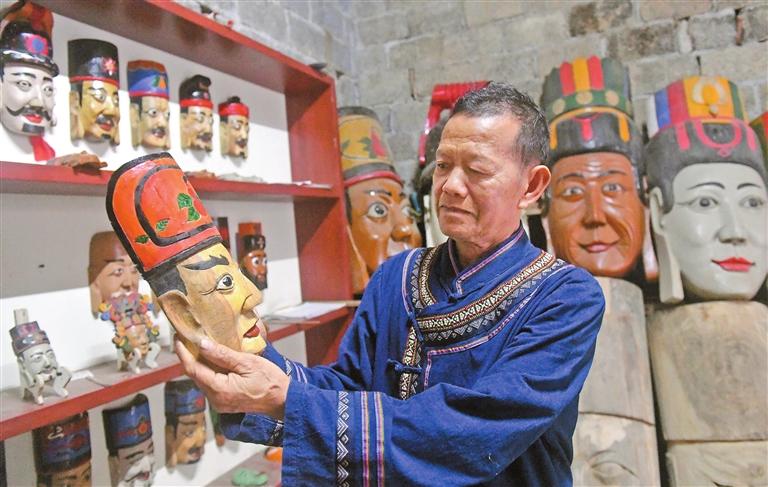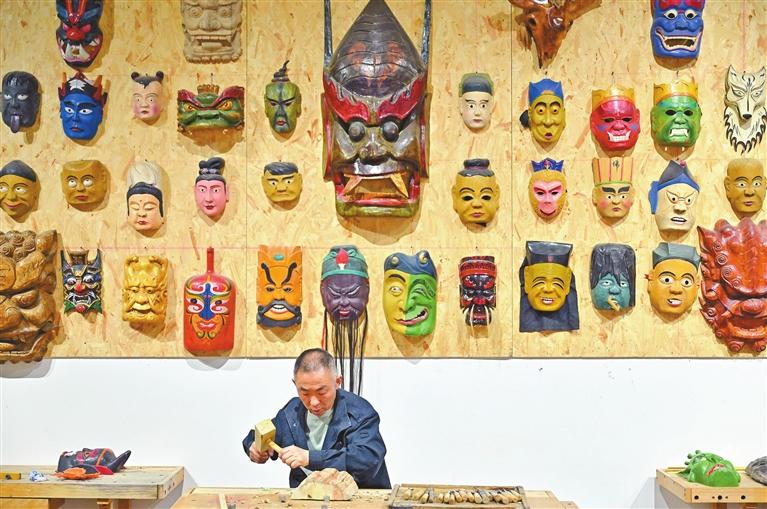





IN Zhongnan Village in southern China’s Guangxi Zhuang Autonomous Region, Tan Jianxin, an inheritor of the wood carving skills of the Maonan ethnic group, carefully carved a Nuo mask. His craftsmanship is a testament to a tradition that has been handed down through generations. Now, that same mask, along with traditional Nuo dance and suona music, is reaching a global audience. It features in the fantasy micro-drama “The War for a Stolen Tradition,” which has been translated into more than a dozen languages and distributed to over 200 countries and regions. The series, available on platforms like Stardust TV, transports global audiences into the heart of China’s intangible cultural heritage. It follows an ancient tribal leader who awakens to protect her people’s Nuo opera legacy, embarking on a journey to reclaim their cultural identity. Nuo opera, a form of traditional Chinese theater distinguished by its use of masks, is listed as a national intangible cultural heritage. As short-form dramas gain global popularity, Chinese producers are increasingly integrating elements of intangible cultural heritage, such as Zhuang embroidered balls and lion dance, into their storylines. “The series focuses on masks and ritual movements, adapting traditional performances for vertical screens,” said Ji Li, a partner at Guangxi’s Shanhai Group. “We’ve combined ethnic minority features with modern visual effects, making the performance both delicate and striking.” This creative experiment is part of a larger trend. Officially recognized as a genre in 2020, micro-dramas have exploded in China. By the end of 2024, domestic viewership hit 662 million, and the market generated 50.5 billion yuan (US$7 billion), surpassing China’s box office for the first time. Chinese micro-dramas are rapidly expanding into overseas markets, from Southeast Asia and the Middle East to Europe, the United States, Japan, and South Korea. With compact storytelling and fast-paced plots, these shows have become a fresh medium for cultural exchange. Short-drama apps recorded over 370 million global downloads in the first quarter of 2025, more than six times the number from a year earlier, according to analytics firm Sensor Tower. By March, accumulated downloads reached nearly 950 million, led by platforms such as ReelShort, DramaBox, and GoodShort. The global rise of this genre marks a notable shift. After decades of importing pop culture, China is now exporting its own and gaining fans around the world. Behind this success lies a formula centered on brevity and intensity. With minute-long episodes, micro-dramas rely on high-stakes plots and constant cliffhangers to hook viewers. “Many episodes climax just before they end. I just can’t help but watch the next one,” said Wang Xiaoping, a fan of the genre. “If I guess right what happens, it feels satisfying; if not, the plot twist feels really smart.” The stories explore universal emotional themes such as love and betrayal, rags-to-riches journeys, identity swaps, and family drama, resonating with people across a broad range of cultures. “Micro-dramas mostly focus on the micro-theme of personal emotional life, telling stories that are easy for overseas audiences to understand and satisfying their emotional needs,” said Zeng Peilun, a media researcher at Fudan University. Many companies are now looking abroad for new growth opportunities. Guangxi, which borders ASEAN countries, has become a key base for firms aiming to reach Southeast Asian audiences. The region’s cultural similarities and high smartphone usage are driving demand, which makes its market even more appealing. “We focus on dubbing and overseas operations, especially for Thailand, Vietnam, and Indonesia,” said Qin Li, general manager of Guangxi Hualibo Media Co. Ltd., adding that the company is also actively seeking co-production and copyright partnerships. As competition intensifies, producers are moving beyond repetitive storylines and investing in diversified content and localized strategies. “Early successes relied heavily on dramatic twists and tropes, but audiences now want more,” said Niu Chaohui, head of overseas business at Shanhai Group. “We’re developing content that incorporates intangible cultural heritage, suspense, gaming, and other genres.” The influence of Chinese micro-dramas is also inspiring local creators in different countries. Nai, a young content creator in Thailand, said, “More Thai teams are learning from Chinese micro-dramas — their rhythm, setting, and shot composition. It’s becoming a methodology to adapt, not just content to consume.” Yao Hua, director of the institute of sociology at the Guangxi Academy of Social Sciences, noted that these productions represent a meaningful blend of “content creation, technology, and cultural communication.” To enhance global understanding, Yao urged continued innovation in storytelling and deeper international cooperation through co-production and IP sharing. The overseas expansion of Chinese micro-dramas is still in its early stages, said Li Tao, general manager of Fung Culture. Like other cultural products, domestically produced micro-dramas face "adaptation" challenges when going overseas, Li said. Chinese domestic micro-dramas are often adapted from online novels with themes such as unbeatable heroes, a character's rise from obscurity, and revenge or romance from either a female or male perspective. Western audiences have better payment habits, but won't stay hooked on CEO romance plots forever, and the demand for high-quality stories is urgent, industry insiders say. Looking ahead, industry professionals see platformization, diversified revenue models, and AI-driven production as key trends. Many companies are already using AI for dubbing, editing, and expanding their audience. “We’re exploring how AI can improve content creation, delivery, and data analysis to strengthen our competitiveness overseas,” Niu said. (Xinhua) | 
